Depending on several factors, to get the best results from your grow room or grow tent, an electric humidifier might be the ideal tool. If you are wondering how to tell whether you need a humidifier for your plants, don’t worry.
I will detail how to determine if you need a humidifier, as well as how to choose the best humidifier for grow tents and grow rooms.
The need for a grow room humidifier is determined by two main factors:
- The type of plants you are growing
- The relative humidity of your local climate
This is a simplified explanation, but in the right circumstances, a humidifier can be the difference between a grow room full of healthy plants and, worst-case scenario, a loss of your harvest.
A little later in the article, there is a complete buyer’s guide to help you chose the correct humidifier. First, let’s have a look at the 7 best humidifiers for a grow room or grow tent.
- Related article: Indoor Gardening for Beginners
7 Best Humidifiers for Grow Room & Grow Tent
1. Venta Comfort Plus LW25 Humidifier – Best Overall Humidifier
The Venta Comfort Plus LW25 Humidifier is my choice as the overall best humidifier for grow rooms. This Venta LW25 is a filter-free and low-maintenance product. The key highlights:
- For grow rooms up to 430 square feet
- Easy-clean
- 5 liter reservoir
- 3 Power levels
- Auto shut off
One drawback with humidifiers is the need to clean them regularly to prevent mold growth. But the Venta Comfort Plus uses a unique disc stack to clean the water of pollutants before it is released into the air. This system negates the need for filters and allows for easy cleaning. The disc stack boasts an impressive 22.5 sq ft surface area.
Cleaning is usually required every 7 to 14 days. It only requires lifting the electrical and fan unit pit, removing deposits from the tray, and rinsing the tank and disc stack.
The Venta Comfort Plus is an evaporative humidifier that uses a cold evaporation method to humidify the air. This method utilizes the surface area of the discs to evaporate the water. This simultaneously humidifies the air, while using the water itself as a filter.
The method is recognized as one of the most efficient and hygienic methods of humidifying a room. This method is also a 100% natural way to purify the air, which helps keep air pollutants from tainting your plants.
The downside to this model is the cost, but what you get for the money is a reliable, consistent, and easy-to-use product that is backed by a 2-year warranty.
Venta Comfort Plus LW25 Pros and Cons
Venta Comfort Plus Pros
- Simple to use and clean
- Reliable
- Adjustable power settings
- Quiet
- Filter free
Venta Comfort Plus Cons
- Pricey
- Some users have reported poorer performance for large rooms
2. HuPro PRO-771 Air Humidifier – Runner Up
The HuPro PRO-771 Air Humidifier runs a very close second place to the Venta LW25. The HuPro is a fully-featured model with these key features:
- Remote Control
- Whisper quiet
- Humidity levels from 30% – 85%
- Rooms up to 500 sq ft
- 360-Degree Nozzle for a rotatable mist
With a 6 liter tank, the HuPro PRO-771 humidifier can handle grow room sizes of up to 500 sq ft. It can also raise the humidity to 85%, this is higher than many of its competitors. This makes it a great choice for those growing plants that thrive in high humidity conditions.
The settings can be controlled by an LED screen with a touch panel or by the included remote control. From either of these methods, you can adjust parameters like the desired humidity, power levels (Low/Medium/High), timer, and sleep mode.
Sleep mode is a great feature for hydroponic rooms with grow lights, as it’s an automatic shut-off for the LEDs on the unit. This ensures there is no light pollution when your grow lights are on their off-cycle.
Another benefit of this model is its low noise level at under 30dB. To put that into perspective, it is about as quiet as someone nearby whispering.
This model uses a water filter to purify and soften the water before it is released into the grow room. It delivers the mist utilizing a nozzle that can rotate a full 360°, ensuring that the humidity is dispersed evenly among your plants.
Filling the machine is easy and the generous size of the tank means it doesn’t need to be done frequently. The top filling tank has a wide opening to facilitate ease of filling.
HuPro PRO-771 Pros and Cons
HuPro PRO-771 Pros
- Automatically reads and adjusts the humidity settings
- Can humidify up to 85%
- Remote control operation
- Sleep mode
- Ultra-quiet
HuPro PRO-771 Cons
- LED is very bright
- One year warranty
3. Everlasting Comfort Cool Mist Humidifier – Best Budget Friendly
The Everlasting Comfort Cool Mist Humidifier is my choice for the best budget grow tent humidifier.
- 6 Liter capacity
- For up to 500 square foot grow rooms
- Ultrasonic
- Whisper quiet
- Filterless
While there are cheaper models on the list, you get a great number of features with this model.
Its 6-liter tank allows you to humidify rooms of up to 500 sq ft for up to 50 hours without needing a refill. It features a variable output nozzle, which gives you precise control over the amount of moisture you want to add to your grow room.
The ultrasonic motor at the heart of this unit makes this another model that has a sound output under 30dB. That’s as quiet as many of the more expensive models.
The savings don’t just apply to the purchase cost of this model either. Its filterless design saves you the ongoing costs of replacing filters, and it is fully covered by a 2-year guarantee.
For safety, it features an auto shut-off feature that detects when the tank is dry and switches the humidifier off automatically. There is also an essential oil tray to add pleasant aromas to the room. You don’t need to add essential oils for your grow room, but it’s nice to have when you plan to use it for other rooms in your house.
Overall, this is an excellent product for the money. However, one gripe I have with this unit is the refill process. The water opening is in the bottom of the tank, so you’ll need to use both hands to lift the tank from the base, then refill it through the valve.
Everlasting Comfort Pros and Cons
Everlasting Comfort Pros
- Great price
- 50 hrs between water refills
- Filterless
- Adjustable nozzles
- Auto shut off
Everlasting Comfort Cons
- Awkward to fill with water
- Difficult to clean
4. Pure Enrichment MistAire Ultrasonic Cool Mist Humidifier – Best Compact Humidifier
If you have a growing tent or a smaller grow room, then the Pure Enrichment MistAire cold mist humidifier is a fantastic choice with these key features:
- 360-Degree Rotating Nozzle
- Optional Night light
- 5-Liter water tank capacity
- Quiet
- Easy-fill
Despite its compact design size the MistAire still boasts a host of features that makes it the perfect choice for smaller rooms that haven’t space for a larger model.
A 360° nozzle to precisely control the direction of the mist, means this can be placed in small rooms and still deliver mist exactly where you need it to go. It is easy to assemble and disassemble for filling and cleaning.
To fill it is simply a matter of lifting the tank off the base, unscrewing the cap, then filling it with water. For its size, it still holds 1.5 liters of water, which can last for up to 25 hrs depending on the mist output rate.
If you run a humidifier continuously to achieve the ideal humidity level in the grow room environment, it will take some energy to check the water level and refill it. You will want to get a larger humidifier instead if that’s the case.
Cleaning it is also simple. All you have to do is periodically clean the ultrasonic disk with the brush provided. Regular cleaning will help with clearing out mineral deposits and white dust if you use hard or tap water. Frequent cleaning will also help prevent mold spores and mold particles.
While the nightlight feature isn’t something that all growers would find useful, I found the light was gentle enough that it shouldn’t affect your plants’ Light and Dark cycles, yet was bright enough for me to check my plants when the grow lights were off.
It has a maximum mist output rate of 150 milliliters per hour. That’s impressive for a device that only measures 8” x 6” x 9” and weighs just over a pound. The mist output level has two settings to choose from, I do feel something was missed here as I think a third moisture level setting somewhere in between the two would be great.
It also has a built-in auto shut-off safety feature that activates when the water is low, or if the tank is removed.
Overall, this is a good smaller humidifier for grow tents to provide humidification for healthy plant growth.
Pure Enrichment MistAire Pros and Cons
Pure Enrichment MistAire Pros
- Compact
- 360° rotatable nozzle
- Easy to fill and maintain
- Filterless
- Great output for its size
Pure Enrichment MistAire Cons
- Only two mist level settings
- Buttons are oversensitive
5. Levoit LV600HH Hybrid Ultrasonic Humidifier
The Levoit LV600HH Hybrid Ultrasonic Humidifier is a great choice for those growing temperature-sensitive plants. Not only can the user control the humidity and moisture output, but it also acts as a cool or warm mist humidifier.
This allows you to pair the mist modes with plant needs and also adjust it from season to season. The key features of this flexible humidifier:
- Select from a warm or cold mist
- Remote control
- Grow room sizes up to 750 sq ft
- Large 6-liter water tank capacity
- Easy clean
The Levoit LV600HH has a built-in humidity sensor that allows it to maintain the current humidity level for your plants without any user interaction. Simply set your desired humidity and the humidifier does the rest for you.
The Levoit features an automatic shut-off feature if it detects the water tank is empty. It can either be controlled from the touchpad or the supplied remote control. The settings are clearly displayed on an LED screen on the front of the unit.
The Levoit can output mist at up to 500mL per hour, and depending on the level of humidity that’s set, it can run for up to 50 hours of operation on a single water tank.
Filling the tank with water and cleaning it are easy. The tank is situated at the back of the humidifier and has a large opening.
You can also set schedules thanks to it 1 to 12 hr timer. It features a display off feature for when your grow lights are turned off. It is also perfect for noise-sensitive areas thanks to its whisper-quiet operation.
Levoit LV600HH Hybrid Pros and Cons
Levoit LV600HH Hybrid Pros
- Warm or cool mist
- Remote control
- Built-in Humidity sensor
- Easy to fill and clean
- Large capacity
Levoit LV600HH Hybrid Cons
- Some users have reported a little water escaping from underneath the unit
- The humidity level sensor isn’t very accurate
6. HiMax Cool Mist Humidifier
The HiMax Cool Mist Humidifier would be my choice as runner-up in the best budget category. It’s a super quiet humidifier that won’t break the bank.
This smart-looking unit can run for up to 50 hrs on one tank and has a rotatable nozzle that can deliver a mist spray up to 2 feet high. This makes it a great choice for people growing taller plants in the grown room and that want to ensure the highest reaches receive their share of moisture.
- 26dB Noise level
- 4-Liter tank
- For grow rooms up to 430 sq ft
- 360° Nozzle rotation
- 2 ft Mist height
The operation of the HiMax couldn’t be simpler. A single rotatable dial at the front of the unit allows for an adjustable mist output rate. This allows you to set the output rate from 60 to 300 milliliters per hour.
The HiMax doesn’t rely on any filters, so there is no need to continually purchase filter replacements to keep it running. Other maintenance aspects like filling and cleaning are also simple. A 95mm water inlet allows you to easily fill it and has room enough that your hand can fit into the tank for easy cleaning.
This humidifier is also among the quietest on the list, with noise levels measured at 26dB. This can be compared to the sound of a whisper.
There is also an optional nightlight feature that illuminates the tank. This can be switched off if desired. And as with every other humidifier here, it has a safety built-in with its auto-off feature.
The one slight letdown with this product was the tank size. The inclusion of a slightly larger tank would have made this my choice of best budget humidifier.
HiMax Pros and Cons
HiMax Pros
- Super quiet
- Easy to use
- Simple to clean and maintain
- Excellent price
- No filters to worry about
HiMax Cons
- It will need to be refilled frequently if run at high settings thanks to a small tank
7. Ideal-Air Commercial Grade Humidifier GSH75 – Best Commercial Humidifier
Finally, if you have a larger scale growing operation, then the Ideal-Air GSH75 Commercial Grade humidifier may be what you are looking for. This unit hooks directly into your water supply using ¼ inch tubing, so you never have to worry about the tank running dry. No more watching water levels and refilling the tank.
The Ideal-Air GSH75’s key features:
- Connects directly to your water supply
- Outputs up 0.4 gallons per hour
- Multi-directional Mist Nozzle
- Covers up to 320 sq ft
- Industrial-grade motor
Every aspect of the manufacturing and materials used on the Ideal-Air GSH75 has been designed to ensure longevity and reliability. The motor is industrial-grade and has been developed to give years of trouble-free usage.
Depending on the humidity needs of your grow room or tent, this humidifier offers coverage for room sizes from 160-320 sq ft.The multidirectional spray nozzle is designed to ensure even dispersal of the mist into your grow room, and depending on your needs, it can disperse up to 0.4 gallons of water per hour.
One word of warning about this model though. Since it’s commercial-grade, the GSH75 is noisier than the other models reviewed above. This is down to the fact that it is designed for commercial and larger growing operations where noise levels aren’t a factor. This operates at 62dB, which is around the sound level of a normal conversation. I’ve shared a decibel loudness chart below.
If you are looking for a commercial humidifier for larger grows, then this unit is robust and reliable. However, to get the most out of it, it is better to pair it with a humidity controller such as the Inkbird Humidity Controller to ensure proper levels of humidity continuously.
Ideal-Air GSH75 Pros and Cons
Ideal-Air GSH75 Pros
- Commercial grade for years of operation
- Connects directly to water supply
- Multi-direction spray dispersal
- Small footprint (12.2” high x 12.2” diameter)
- Can output up to 0.4 gallons per hour
Ideal-Air GSH75 Cons
- Is the noisiest of all models reviewed
- Requires extra equipment to get the most out of it
How to Choose a Humidifier for a Grow Tent and Room – Buyer’s Guide
What Is Humidity?
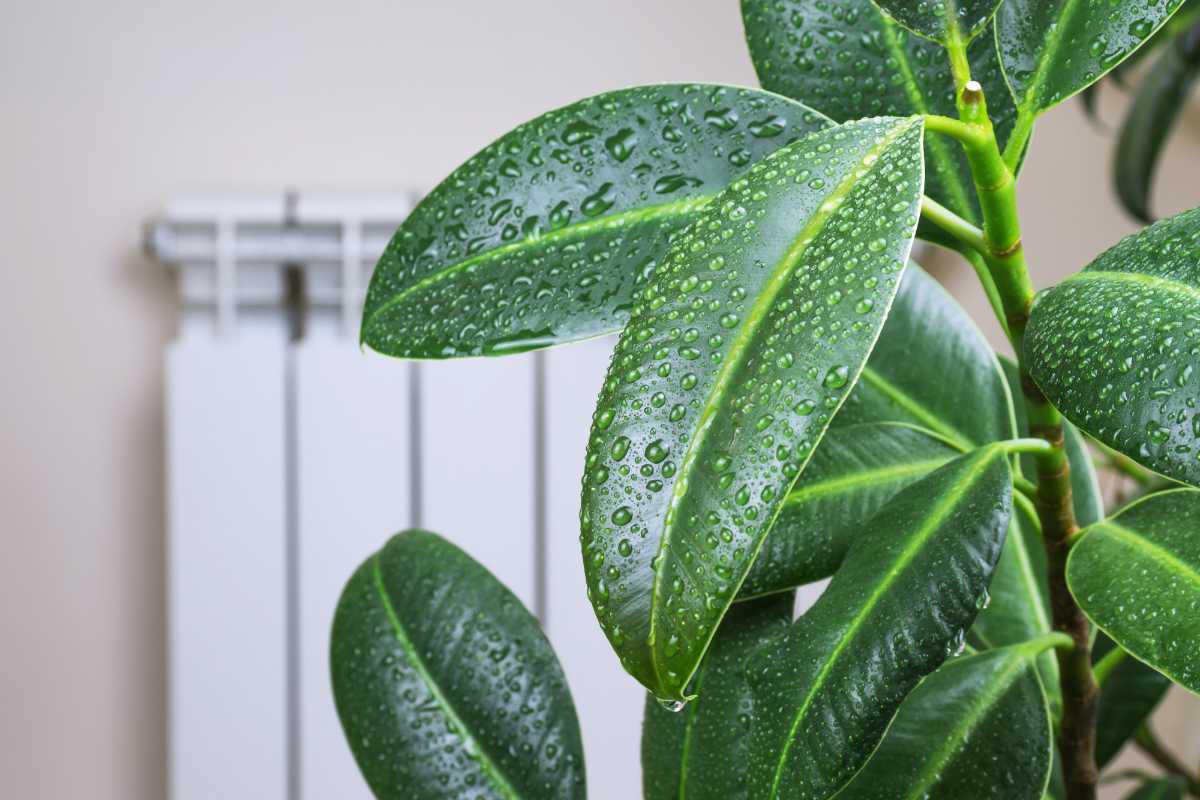
Put simply, humidity is the measure of the amount of moisture that is present in the air.
If you have ever felt hot and sticky and unable to cool down, this unpleasant feeling is due to high humidity. When it’s hot outside, humans keep cool by perspiring because the evaporation of sweat works to cool us. In high humidity environments, the air is already clogged with water vapor, so perspiration doesn’t evaporate efficiently.
Humidity is measured as a percentage of moisture in the air. It can range from 0% which could be a desert area, to 100%, this could be a completely misty day.
Plants have different humidity requirements depending on the type of plant. Typically, houseplants love average humidity levels of 30-40%. However, certain types of plants require humidity levels of 60% or above.
As a guideline, plants that have thinner and more delicate leaves will require higher humidity levels.
Do I Need a Humidifier in My Grow Tent and Room?

Not everyone will need a humidifier. If you already live in a humid area and are growing plants that don’t have high humidity requirements, then a humidifier might do more harm than good.
Too much humidity can cause issues like powdery mildew and bud rot, as well as reducing the efficiency of nutrient absorption in your plants. Plants will take in less water through their root systems and therefore, fewer nutrients.
If you are unsure about whether you need a humidifier, then the easiest way to check is to measure the humidity in your room. A hygrometer is a cheap tool that is essential in a grow room. It will give an accurate humidity measurement in your grow room and tent, which can then be compared against the humidity needs of your plants.
Even if you do discover that humidity levels are on the low side, for smaller rooms simply placing a basin of water and blowing a fan across the surface could be all you need.
A little trial and error will be needed, so a hygrometer will be helpful.
How Much Humidity Should be in a Grow Tent?
There is no set answer to this question. The humidity of the air needed inside your grow tent or room is dependent on several factors. These include:
- The type of plant you are growing
- The current environmental humidity
- The stage of plant growth
The first thing to check is the humidity levels that suit your plants. Plants that require high humidity include ferns, nerve plants, orchids, and most other plants that are native to tropical areas.
Another factor is the stage of plant growth. For instance, certain types of plants have the following humidity requirements throughout their life cycle.
- Seedling and early vegetative stage – 70-75%
- Vegetative – 50-70%
- Flowering – 40-50%
Be check to check out various houseplant care guides to determine what’s best for your plants.
Main Types of Humidifiers
Cool and Warm Mist Humidifiers

As the name suggests, this type of humidifier can produce a warm or cool mist. In most instances, you choose one or the other, but there are humidifiers available that will let you switch between the two. Check out the excellent Levoit LV600HH Hybrid Ultrasonic Humidifier for an example of one.
In general, a cool-mist humidifier uses a filter to extract impurities from the air before releasing a cool and barely visible mist into your grow room. If you are having issues with high temperatures in your grow room, then one of these would be a good option. These are also generally considered easier to clean than the warm mist models.
- Learn more about How to Cool a Grow Tent.
Warm mist humidifiers produce a more visible vapor that is slightly warm. These are less effective in larger rooms and are more difficult to clean than the cool mist models.
Ultrasonic Humidifiers
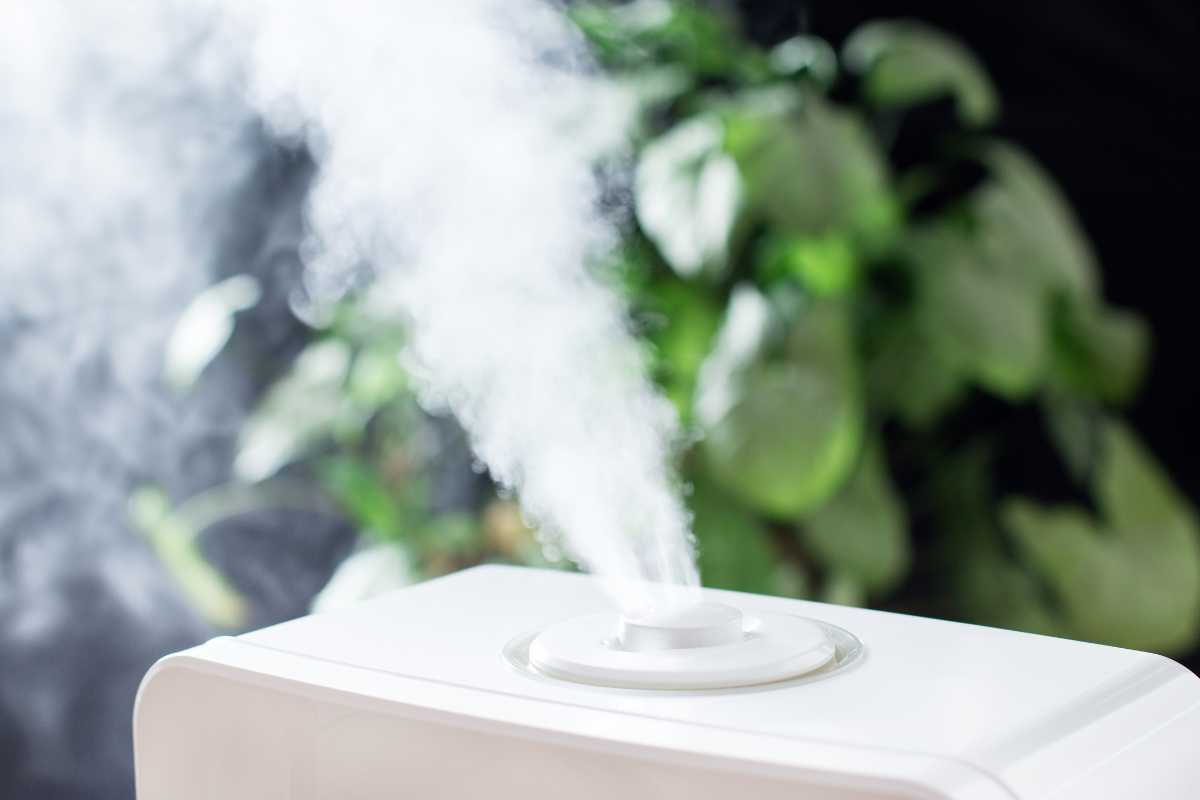
An ultrasonic humidifier vibrates the water at an ultrasonic frequency using a metal diaphragm. This action creates tiny water droplets that are then dispersed into the room via a fan.
These are usually the quietest of all humidifier types and are low maintenance. The mist they produce is of the “cool” type.
Evaporative Humidifiers
Evaporative technology uses the wicking action of a filter to draw the water from the humidifier’s tank. This filter clears the impurities from the water and a fan is blown across the surface of the filter to evaporate the water and introduce it into the air.
These are usually noisier than other models and require more maintenance.
Grow Room and Tent Size

Ensuring the humidifier you purchase can cope with the size of your grow room is crucial. Most humidifiers will give you the maximum room size that the device is rated for. This is generally expressed in square feet.
Knowing the square footage of your grow room is something you should measure before buying a humidifier. Other factors to consider when making your purchase include the number of plants you are growing and the height of your ceiling.
I would always suggest buying a size up from what you need as you can use a lower setting at first and adjust if required. Larger grow rooms will often employ 2 or more humidifiers.
While, there are too many variables to give precise figures, the table below has some guidelines:
| Room Size (in feet) | Recommended Humidifier coverage (Sq. ft) | Example |
| 10 x 10 | 100 | Pure Enrichment MistAire |
| 15 x 15 | 225 | Ideal-Air GSH75 Commercial Grade Humidifier |
| 20 x 20 | 400 | HuPro PRO-771 Air Humidifier |
| 25 x 25 | 625 | Levoit LV600HH Hybrid Ultrasonic Humidifier |
Look at online shops for grow rooms and tents for their sizes. This is one of the more popular grow rooms:
Where to Put the Humidifier in the Grow Tent?
There are no hard and fast rules, common sense dictates that you wouldn’t want it sitting next to an electrical socket (just in case). Apart from that, you need to have it somewhere it can distribute the humidity evenly among your plants.
It is also sensible to position it somewhere it can be easily accessed. Remember you will need to fill this frequently and perform maintenance like changing filters or cleaning.
All the humidifiers I have selected on the list can be used as free-standing devices, so it is easy to play around with the positioning until you find the ideal spot.
Using a hygrometer to detect the humidity level in various locations in your tent can be useful for finding out just how well-positioned your humidifier is.
Water Tank Capacity
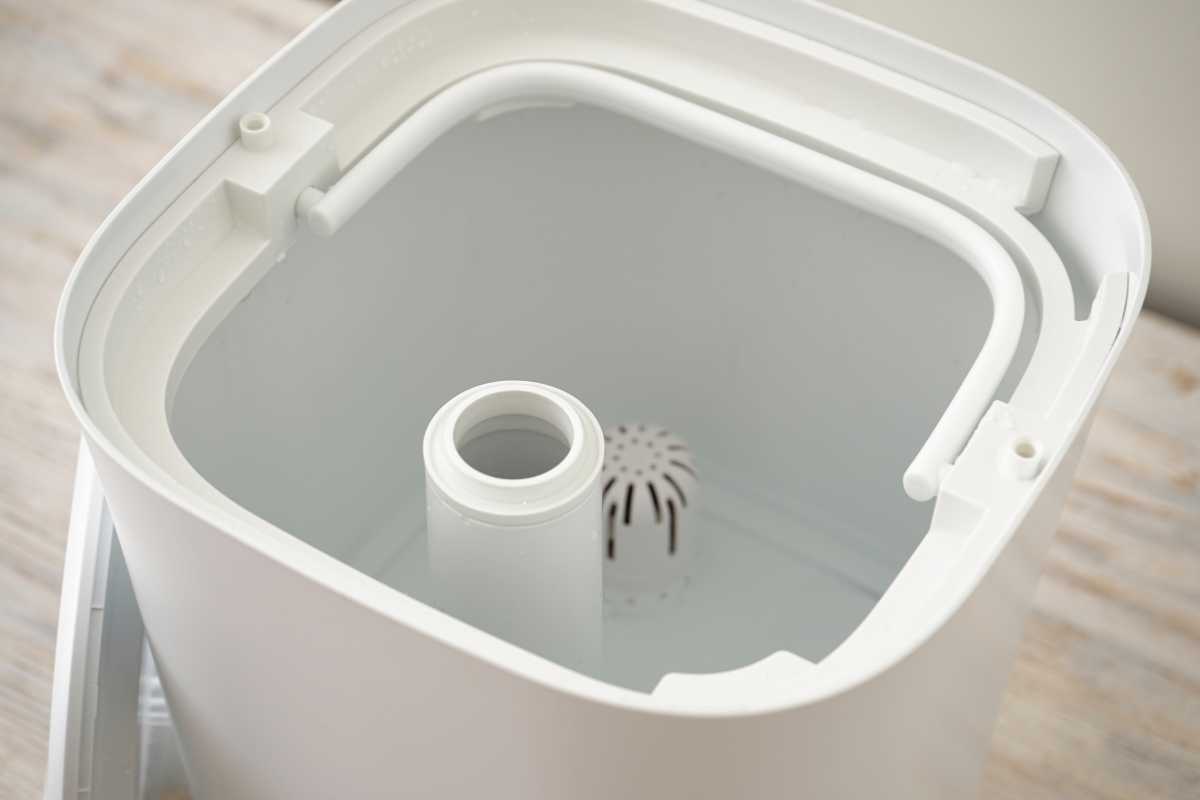
Water tank capacity varies from device to device and is one of the factors that define what size of room a humidifier is rated for. The humidifiers here vary from 1.5 to 7.5 liters, except the Ideal-Air GSH75 Commercial Grade Humidifier which is linked directly to a water source.
While the size of the water tank shouldn’t be a deal-breaker, remember the smaller tank, the more often you will need to refill and clean it.
Humidity Level Adjustments
The ability to adjust the amount of humidity that the unit releases into your room is essential. Most of the models have some form of adjustment, even if it’s just a high or low setting. For most people, this is all that is required.
More complex humidifiers use an internal hygrometer to determine the current humidity in the room, and adjusts moisture output as needed.
A good compromise that I have used with success is to put a programmable timer switch on your wall outlet and use this to turn your humidifier on and off.
I used a hygrometer and some experimentation with running times for the humidifier. I soon found the ideal amount of time and spacing between power-ups to keep my grow room at the perfect humidity.
- Learn more about How to Control Humidity in a Grow Tent.
Humidifier Filters
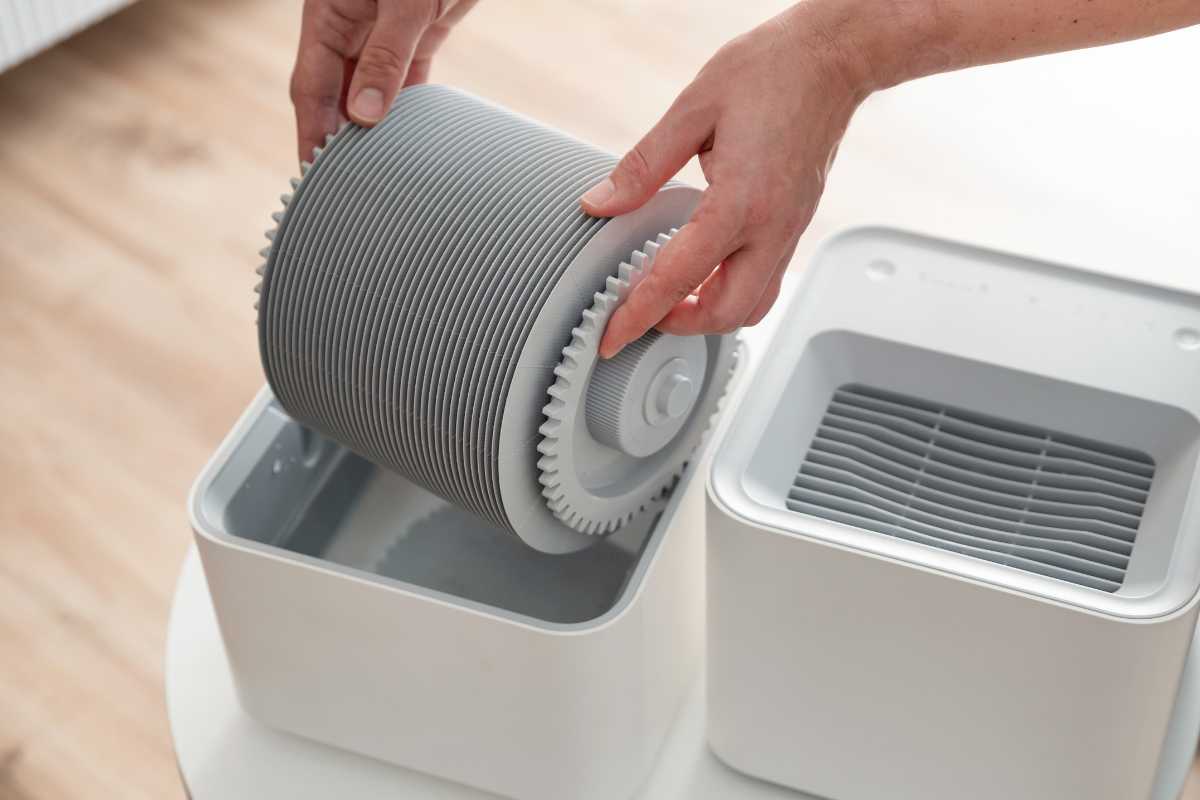
The use of filters is common in many types of humidifiers. These remove impurities from the air and ensure that the spray released into the room is clean for both you and your plants.
In the case of most evaporative humidifiers, they also act as the “evaporation surface” from where the water is released into the air.
Many of the humidifiers I have listed have a filter-free design and for many people, the convenience of not keeping a filter supply makes these a better choice.
Noise Levels
Noise levels are one area that many people will find important. No one wants something that sounds like a washing machine running constantly. If your grow room is situated inside your home or somewhere else where noise levels are likely to be an issue, then this is going to be one of your deciding factors.
Except for the commercial-grade Ideal-Air model, all the models I have listed are ultra-quiet. Many of them are designed to be used in bedrooms and other rooms throughout the house, as well as being used in grow rooms.
To give you an idea of the noise levels you can expect to hear from a humidifier, most of them are rated 32dB or under. This is the equivalent noise that you’d hear if someone close by was whispering to you.
| Noise Source | Decibels dBA |
| Jet engine at 100 feet | 140 |
| Where Pain Begins | 125 |
| Power mower | 107 |
| Telephone dial tone | 80 |
| Normal conversation | 60-70 |
| Household refrigerator | 55 |
| Surburban area at night | 40 |
| Whisper | 25 |
| Quiet natural area with no wind | 20 |
Care and Maintenance
These are not high-maintenance devices. Apart from keeping the water tank filled, it is usually just a case of cleaning regularly and changing the filters.
How often you have to clean is down to factors including: –
- How long it has been running for
- The water used (hard water, soft water, distilled water, etc.)
- The type of humidifier
It is always good practice to acquaint yourself with the manufacturer’s instruction manual and maintenance guidelines for how often to clean the humidifier. In most cases, once every 7-14 days is sufficient.
How to Use the Humidifier to Create Humidity
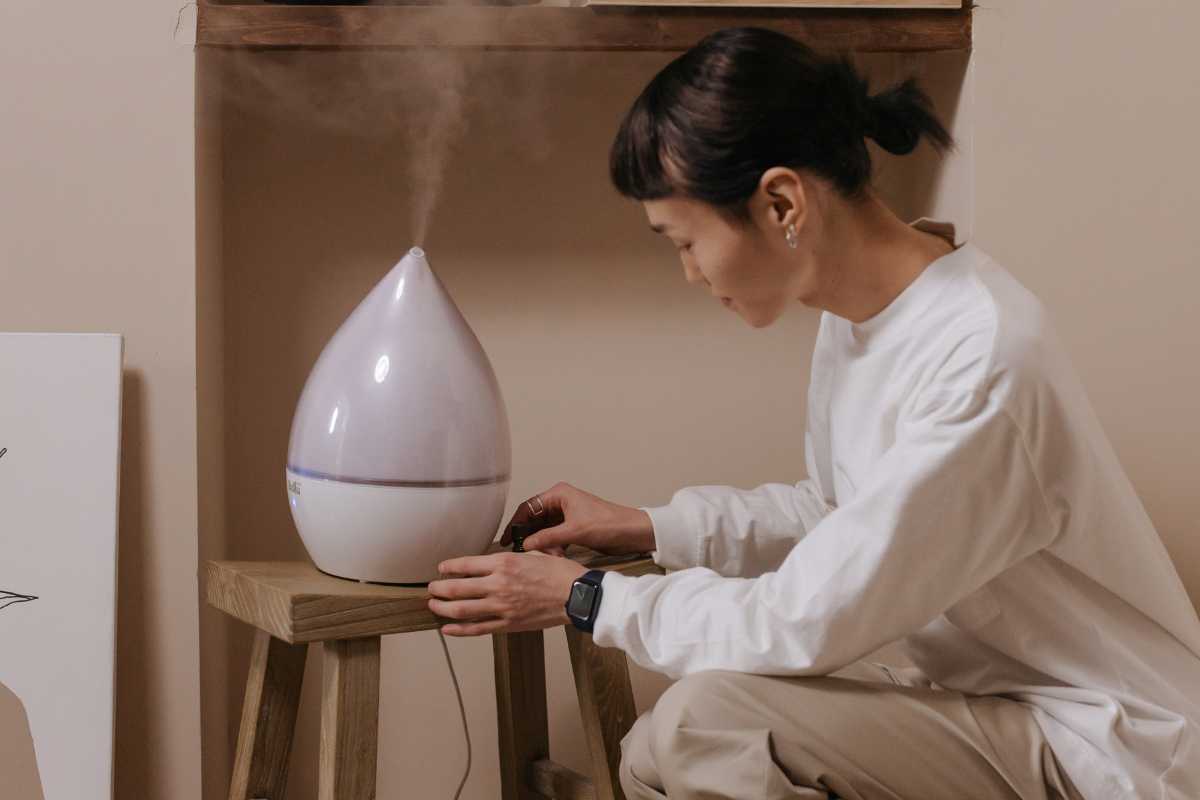
These are pretty straightforward devices to use and a degree in rocket science isn’t needed at all. Only a few simple steps are needed to start using your humidifier:
Step 1
The first step is to get the humidifier ready as per the manufacturer’s instructions. This usually only involves filling the water tank and reattaching it to the unit, if not already connected.
Step 2
Place the humidifier in an appropriate position in your grow room or tent. This may need some tweaking dependent on how it performs. I always start as close to the center of the room and the plants as possible and adjust from there.
Step 3
Switch the humidifier on.
Step 4
Step 4 is really more of an ongoing step. This is where a hygrometer is extremely useful. At this stage, you need to be monitoring the overall humidity in your grow room and ensuring the humidity is consistent throughout the room. You can then adjust how much humidity is being introduced and the position of your humidifier.
Remember that this is ongoing, background humidity levels vary from season to season, and even day-to-day.
Humidifiers for Grow Tent and Grow Room FAQs
Should I put a humidifier in my grow tent?
You should put a humidifier in your grow tent if you have a problem with plants “drying out” from a lack of humidity in the environment. Not all grow rooms will require this, and for some, it may only be needed on a seasonal basis.
Where to place a humidifier in the grow tent?
When placing a humidifier in your grow tent, you need to ensure that it is easily accessible for cleaning and filling. It also needs to be in the optimal position to allow an even spread of humidity throughout your grow tent.
Should a humidifier be inside or outside the grow tent?
When deciding whether to place your humidifier inside or outside your grow tent, one big deciding factor is the temperature. If you have issues keeping the temperature down, then placing your humidifier inside the tent will add to this problem.
Where should you not put a humidifier?
You should not put a humidifier anywhere it is likely to spray mist onto electrical outlets. It is also good practice to keep them at a distance from vents or heaters as this can distort readings from built-in hygrometers.
Can humidifiers damage grow lights?
Humidifiers won’t damage grow lights if they are positioned correctly. Always make sure the mist is not spraying directly down onto the lights.
Should you run your humidifier all day?
You can run your humidifier all day if you live in a dry climate and need consistent, high humidity levels. These devices are designed to be energy efficient and run safely for long periods of time. However, it isn’t always necessary to do so. Remember, depending on the plant, too much humidity can be as bad for your plants as too little is.
Should every room have a Humidifier?
It isn’t necessary for every room to have a humidifier. It is always best to check the humidity in each room and the humidity needs of the plants you’re growing in a specific room. If the humidity level isn’t high enough for your plant to flourish, then you can add a humidifier for your plants.









